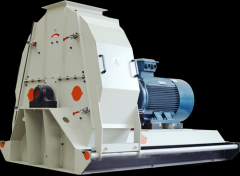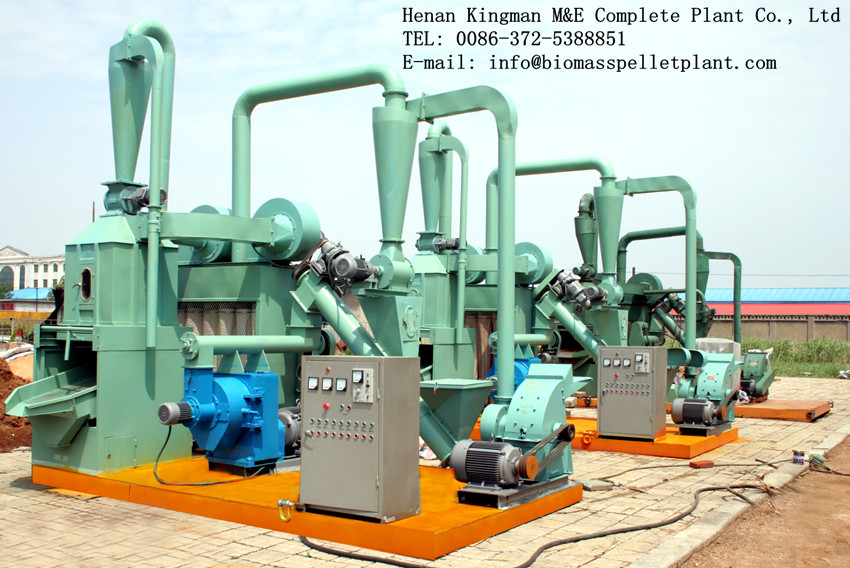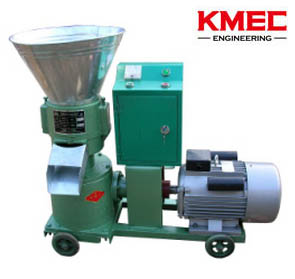The measures to deal with the quick wearing parts of biomass pellet mill
In order to deal with the problems of quick wearing of biomass pellet mill, we should mainly start with the material, the main quick wearing parts should be made of material with high hardness and high wear-resisting property, it can effectively improve the wearing condition, to increase the use and repair cycle of formation equipment. The high anti-resisting material is mainly classified into metal wearing anti-wearing material and non metal anti-wearing material.
1. Metal material with high anti-resistance property
1).High carbon alloy steel
The advantages of high carbon alloy is high hardness, the surface hardness is usually up to about HRC60 after the treatment of tempering, carburizing and nitriding. It has high hardness and good wearing resistance property. The disadvantages of it is bad processing properties, it usually has bad toughness after heat treatment. Therefore, the high carbon alloy steel is mainly made of quick wearing parts, like the sleeve pipe of formation sleeve, which improve the wearing property of formation equipment. It is necessary to pay attention to the design of formation mold, to avoid of direct hitting.
2).Stainless steel
The utilization of stainless steel in the biomass pellet mill equipment has good performance to deal with the wearing issue of pellet mill. The most tropical stainless steel with good performance is 4Cr13; it belongs to Marten site stainless steel with high carbon content. Therefore, it has high strength, hardness and anti-wearing property. The tropical processing technology is CNC gun drilling machine drilling and heat treatment of vacuum gas quenching furnace (Nitrogen cooling). The surface hardness after tempering is up to about HRC58, the hardness of the center is up to HRC52.
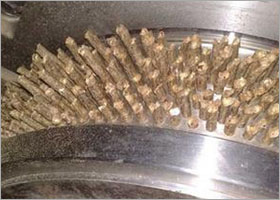
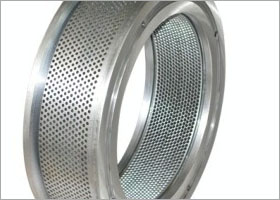
After the heat treatment, the stainless steel has much better comprehensive property. Comparing with low carbon alloy steel and high carbon alloy steel, the low carbon alloy steel has good strength which are easy to process with corrosion resistant and hitting resistance, but the disadvantages is low hardness after heat treatment with average anti-wearing resistance; stainless steel has integrated the advantages of them, it has good strength, corrosion resistant, easy to processing, the hardness and anti-wearing ability are both good, it received good application effect. The disadvantage is high price, the cost at the early stage is much higher, but the price is low if the production cost averaged in per ton due to its long repair cycle. But, it still needs to improve the high anti-wearing non metal material in order to fundamentally improve the current situation of quick wearing of biomass pellet fuel formation equipment.
2. Non metal anti-wearing material
The high hardness of non metal anti-wearing material is mainly ceramic anti-wearing material. Since 20 century, many new technology has been emerged, people has much more deep understanding toward the relationship between the material structure and its property. Through controlling the chemical ingredients and microstructure of the material, many ceramic materials with different features have been researched. The hardness of these ceramic materials are several times of the common metal, as well as its own characteristics of good anti-wearing, thermostability and corrosion resisting etc, that make it has been widely applied in many important regions.
Currently, the application of ceramic anti-wearing material in the biomass pellet mill equipment is still in the primary stage. Henan Agricultural University has test the application of ceramic anti-wearing material in the piston stamping pellet mill and flat die pellet mill separately, it has received good result.
Hydraulic drive piston stamping pellet mill researched by Henan Agricultural University, the biomass material enter through the feeding hopper, after pre-compression and enter into the formation pipe sleeve. Under the outer heating and squeezing force of piston, the feedstock is compressed in the formation pipe sleeve. Due to the strong pressure of formation forth, the wearing of formation pipe sleeve is serious. We re-designed the formation pipe sleeve and the heavy-wearing part of contraction section is made of alumina ceramics with high wear-resistant property. We use the peanut shell for testing of 100h compression formation in contrast with alloy steel of 30CrMo with carburizing of inside holes and HF surface quenching. After the test of 100h for contrast, the length of wearing at the mouth of alloy steel formation sleeve is about 1mm, but the bottom of ceramics pipe sleeve has no wearing. Form the above; we made a conclusion that the ceramics anti-wearing material has good performance than the common metal anti-wearing metal material.
In all, the stability of utilization of biomass pellet mill equipment is improved increasingly as the development of biomass formation technology. The quick wearing is still a problem with urgent treatment. Currently, the cycle of use and repair of biomass pellet fuel formation equipment is no more than 500h, few manufactures adopt the 45#steel without any treatment, the using cycle is even not more than 50h. The issue of quick wearing of wearing-parts of biomass pellet mill is becoming the bottleneck of restricting its development.
The die and roller are the most wearing parts of biomass pellet mill, especially for a large biomass pellet production line. They need to be checked and replaced regularly when worn out. The friction between the wearing parts of ring die pellet machine is much smaller than briquette press. So the wear of pelletizing is relatively smaller than briquetting. The lifespan of ring die is generally 2000 ~ 3000 hours. The die and roller of high quality can help improve the capacity and economy performance of biomass pellet mill. By adapting advanced manufacturing technology around the world and continuous development and innovation, KMEC always stand at the front of biomass industry and committed to provide our customers with biomass pellet mill and pellet plant of the highest quality.
-------------------------------------------------------------------------------------------------------------------------------------------------
News
- Small Pellet Machine Manufacturer-Kingman
- Application of Wood Pellets and Use of Biomass Pellets
- From Fossil Fuel into Biomass Pellet Fuel
- Biomass Pellet Making Machines Market
- Applying of pellet stoves for home use
- Highland pellets to build $130 million facility in arkansas
- How to deal with the blocked hammer mill
- How to Make Wood Pellets with Sawdust
- The government policy promotes the development of biomass fuel
- Market analysis of biomass pellet fuel
- Strategic positioning of renewable energy
- Biomass energy has pass through the pre assessment
- The key point of deep processing of biomass pellet
- Harbin is promoting the development of biomass machinery
- The development of biomass formation technology I
- The development of biomass formation technology II
- Biomass energy industry is now going full tilt in 2015
- Rapid increasing demand of sawdust pellet on the market
- Pellet fuel market in EU
- Chinese Biomass Energy Conference held in Beijing
- Future market development of straw pellet mill
- Peanut Shell Pellet Mill Makes High Quality Pellets
- The utilization of straw is only 5%, biomass energy needs our attention!
- Corn straw pellet machine relieves the tight supply of fuel energy
- Reasons for loose or not forming of biomass pellet mill


